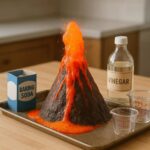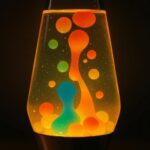Bouncing Water Droplets: The Leidenfrost Effect Explained Visually
Have you ever witnessed a phenomenon where water droplets seem to bounce and hover on a hot surface as if defying gravity? This mesmerizing effect is known as the Leidenfrost effect, a remarkable demonstration of physics in action. In this blog post, we will delve into the science behind this intriguing phenomenon, explore its visual aspects, and discuss its practical applications.
The Leidenfrost Effect: What Is It?
The Leidenfrost effect is named after Johann Gottlieb Leidenfrost, who first described the phenomenon in the 18th century. It occurs when a liquid droplet is placed on a surface significantly hotter than the liquid’s boiling point. Instead of immediately evaporating, the droplet skates on a thin layer of its own vapor, a process known as ‘levitation.’
This effect is most commonly observed with water droplets on a hot pan, where the droplets appear to bounce and move rapidly. The vapor layer acts as a cushion, reducing friction and thermal conductivity, allowing the droplet to move freely while slowly evaporating.
How Does the Leidenfrost Effect Work?
Understanding the Leidenfrost effect requires insight into the physics of heat transfer and phase changes. Here’s a breakdown of the process:
-
Initial Contact: When the liquid droplet comes into contact with the hot surface, the bottom layer instantly vaporizes. This rapid vaporization creates a thin layer of gas (vapor) between the droplet and the surface.
-
Vapor Layer Formation: As more vapor is produced, it forms a cushion that prevents the droplet from making direct contact with the hot surface. This vapor layer is crucial as it reduces heat transfer and allows the droplet to ‘hover.’
-
Droplet Movement: With the vapor layer in place, the droplet can move freely across the surface. The reduced friction and heat transfer cause the droplet to either bounce or roll, depending on the surface’s tilt or any applied force.
-
Evaporation: Over time, the droplet continues to lose mass through evaporation, eventually shrinking until it either disappears or comes into contact with the surface, at which point it will splat or evaporate rapidly.
Visualizing the Leidenfrost Effect
Visualizing the Leidenfrost effect helps in understanding its dynamics. High-speed cameras can capture the detailed motion of the droplets. Here are some visual insights:
-
Droplet Impact: Upon initial impact, the droplet flattens slightly before the vapor layer forms. This is the moment when the vapor cushion starts to develop.
-
Vapor Trail: As the droplet moves, it leaves behind a trail of vapor, creating a visible path that highlights its movement.
-
Multiple Droplets: When multiple droplets are present, they can interact in fascinating ways, sometimes merging or following similar paths across the surface.
-
Bouncing Motion: The droplet’s movement can be erratic, bouncing off the edges of the surface or other droplets, creating a dynamic and engaging visual display.
Real-World Applications of the Leidenfrost Effect
While the Leidenfrost effect is a fascinating scientific phenomenon, it also has practical applications:
-
Heat Transfer and Cooling: The Leidenfrost effect is being studied to improve cooling systems, where minimizing contact between liquids and hot surfaces can enhance efficiency.
-
Non-Stick Surfaces: Research into superhydrophobic surfaces often draws inspiration from the Leidenfrost effect, aiming to create surfaces where liquids can roll off easily.
-
Medical Applications: In some medical procedures, understanding how droplets interact with surfaces at different temperatures is crucial for drug delivery and sample handling.
-
Culinary Innovations: This effect is of interest in cooking, particularly in techniques where controlling the interaction between food and hot surfaces is key to texture and taste.
Recreating the Leidenfrost Effect at Home
If you’re intrigued by the Leidenfrost effect, you can easily recreate it at home with a few simple materials:
Materials Needed:
- A clean, smooth surface (such as a stainless steel pan)
- Water
- A heat source (stove or electric burner)
- A spoon or dropper
Steps:
-
Heat the Surface: Place the pan over medium-high heat and let it heat up for several minutes until it becomes very hot. To test if it’s ready, flick a few water droplets onto the surface; they should sizzle and evaporate almost immediately.
-
Drop Water Droplets: Using a spoon or dropper, release small droplets of water onto the hot surface. Observe how they move and behave.
-
Experiment with Temperature: Adjust the heat and the size of the droplets to see how these factors influence the Leidenfrost effect. Notice that extremely hot surfaces and smaller droplets tend to showcase the effect more prominently.
-
Practice Safety: Handle hot surfaces with care, and keep a safe distance to avoid burns.
The Future of the Leidenfrost Effect
Research into the Leidenfrost effect continues to expand our understanding of fluid dynamics and heat transfer. Advances in materials science and nanotechnology could lead to new surfaces that exploit this effect for various applications, from improving medical devices to enhancing industrial processes.
Moreover, the study of this phenomenon contributes to broader scientific inquiries, such as understanding how substances behave under extreme conditions, which can inform fields like aerospace engineering and advanced manufacturing.
Conclusion
The Leidenfrost effect offers a captivating glimpse into the intricate world of physics, where everyday phenomena hide extraordinary scientific secrets. By observing bouncing water droplets, we gain insights into heat transfer, surface interactions, and fluid dynamics—all of which have broader implications for technology and innovation.
Whether you’re a scientist, a student, or simply someone fascinated by the natural world, the Leidenfrost effect invites you to explore and appreciate the beauty of physics in action. So next time you see water droplets dancing on a hot surface, remember the science that makes this mesmerizing display possible.
Join the conversation and share your thoughts or experiences with the Leidenfrost effect in the comments below. Who knows? You might just inspire the next breakthrough in this fascinating field of study.



